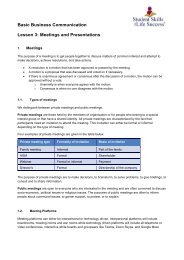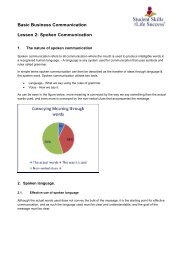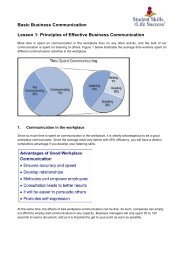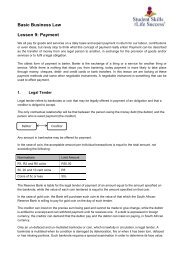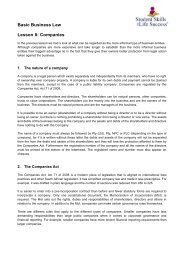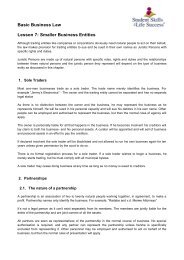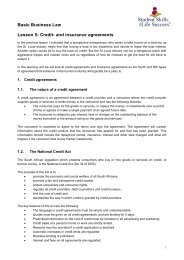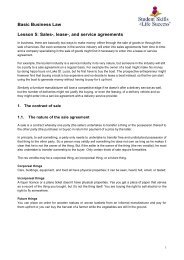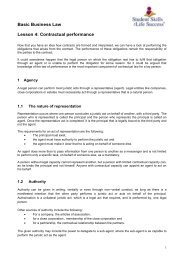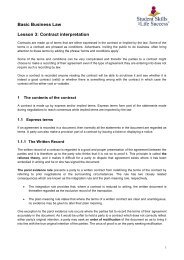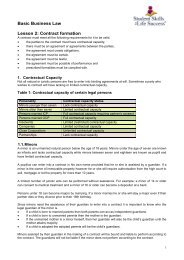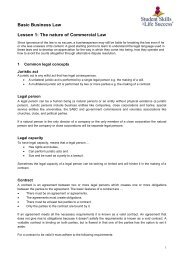Basic Business Communication. Lesson 4. The Nature of Written Communication
This is the fourth lesson for Basic Business Communication. The following topics are covered in this lesson: 1. The importance of effective written communication. 2. Working definition of written communication 3. Reading techniques 4. Grammer 5. Punctuation 6. Style considerations 7. Effective headings 8. Layout and graphics 9. Precis 10. Editing 11. Persuasive Writing Video Link https://youtu.be/k5UVqdgTxKk
This is the fourth lesson for Basic Business Communication. The following topics are covered in this lesson:
1. The importance of effective written communication.
2. Working definition of written communication
3. Reading techniques
4. Grammer
5. Punctuation
6. Style considerations
7. Effective headings
8. Layout and graphics
9. Precis
10. Editing
11. Persuasive Writing
Video Link
https://youtu.be/k5UVqdgTxKk
You also want an ePaper? Increase the reach of your titles
YUMPU automatically turns print PDFs into web optimized ePapers that Google loves.
<strong>Basic</strong> <strong>Business</strong> <strong>Communication</strong><br />
<strong>Lesson</strong> 4: <strong>The</strong> <strong>Nature</strong> <strong>of</strong> <strong>Written</strong> <strong>Communication</strong><br />
1. <strong>The</strong> importance <strong>of</strong> effective written communication<br />
<strong>The</strong> problem when using written communication in the workplace is that there is already an overload <strong>of</strong><br />
reports, memos, e-mails, and other documents. Only a small portion are these are ever read or used, and<br />
when there is information overload it is easy for important information to get lost. If you read a million words a<br />
month, and you do so with 80% recall, you are still going to forget 200 000 words, and some <strong>of</strong> those might<br />
have been very important.<br />
Since the business environment is so busy, your written communication must be simple and clear, so that<br />
you can get a speedy reply. Good written communication will ensure the following:<br />
• Misunderstandings can be avoided, as a paper is more reliable than human memory.<br />
• <strong>The</strong> written record <strong>of</strong> events gives the company legal protection.<br />
• When there is disagreement, written documents facilitates understanding.<br />
• <strong>Written</strong> communication is permanent.<br />
• It serves as an important record.<br />
• It creates a pr<strong>of</strong>essional image.<br />
2. Working definition <strong>of</strong> written communication.<br />
A communication process, where meaning is transferred from the writer to the reader, through information<br />
that is recorded as written language.<br />
<strong>The</strong> cyclical nature <strong>of</strong> this process and the typical barriers associated with written language is illustrated<br />
below.
Without the benefit <strong>of</strong> non-verbal communication to enhance the meaning, the<br />
written language ability <strong>of</strong> the parties will directly determine whether the<br />
communication is successful or not as it is the only tool through which the encoding and decoding is<br />
happening.<br />
3. Reading techniques<br />
<strong>The</strong>re are only two tools available in written communication, and that is reading and writing. Whatever we<br />
write, will be informed by what we have already read. In other words, if you want to be a good writer (sender)<br />
you need to be a good reader (receiver) 1 st .<br />
Depending on your goals, you can use different reading techniques to turn you into a better reader. <strong>The</strong><br />
different techniques are summarised below, and although clearly distinguishable, they are not necessary<br />
mutually exclusive.<br />
Scanning<br />
Technique Description Example<br />
You read to identify specific information by<br />
scanning the text.<br />
Reading the executive summary<br />
<strong>of</strong> a report.<br />
Skimming<br />
Reading to only get a general idea <strong>of</strong> what<br />
the text is about.<br />
Reading your news feed on the<br />
way to work.<br />
Active Reading You read to gain an in-depth understanding. Preparing for a sermon.<br />
Detailed Reading<br />
Speed Reading<br />
Intensive Reading<br />
You read with the goal to remember the<br />
details.<br />
You read to re-familiarise yourself with<br />
known texts.<br />
You read to understand and evaluate the<br />
text.<br />
Studying for an exam.<br />
Preparing for a meeting.<br />
Reading for a dissertation.<br />
Extensive Reading You read for pleasure. Reading a novel.
Structure-Proposition-<br />
Evaluation Reading<br />
Survey-Question-<br />
Review Reading.<br />
You read, not only to evaluate the text, but<br />
also the underlying structure and arguments<br />
You read so that you can understand and<br />
teach the content to others.<br />
Preparing to interview an expert.<br />
Preparing for a lecture<br />
<strong>4.</strong> Grammer<br />
When writing, your communication can be either direct or indirect. <strong>The</strong> difference between the two is that<br />
when your communication is direct, it is directed at a specific person or persons, and you expect a response,<br />
but when it is indirect, you use an assortment <strong>of</strong> media and you do not expect a direct response. Once again,<br />
the two are not mutually exclusive, for example, when you place an add using media, it is a mass<br />
communication tool, but you are dependent on your prospects responding to it or you will not see a return on<br />
your investment.<br />
In order to get the desired response from your audience, we must consider the same principles we did in<br />
spoken communication like audience, purpose, and style, but you must also use good grammar. Remember,<br />
you cannot count on non-verbal communication to enhance the meaning when using written communication.<br />
You can quickly improve your grammar by following the principles below.<br />
• Develop your vocabulary. - <strong>The</strong> body <strong>of</strong> words used in a particular language.<br />
• Rather use the active voice. - <strong>The</strong> verb follows a direct object.<br />
• Pay attention to punctuation. - <strong>The</strong> correct use <strong>of</strong> spacing, marks and symbols.<br />
• Use neologisms sparingly. - A new word or expression.<br />
<strong>The</strong>n try to avoid the following in your writing.<br />
• Irony. - <strong>The</strong> words contradict the meaning.<br />
• Repetition. - Repeating what was already said.<br />
• Redundancy. - Using words with the same meaning unnecessary.<br />
• Verbosity. - Using more words than needed.<br />
Below are a couple <strong>of</strong> examples <strong>of</strong> badly written communication.<br />
• “I am here to tell you that this Government is a government for the people because we are serving<br />
the people”.<br />
• “<strong>The</strong> future potential <strong>of</strong> this investment is good for the future”.<br />
• “<strong>The</strong> airline reservation system handles airline reservation data”.<br />
• “In view <strong>of</strong> the downturn, we downsized”.<br />
5. Punctuation<br />
Make sure that you use the correct spacing, marks, and symbols in your writing. For example.<br />
• Apostrophe (‘) - Shows that the noun owns something.<br />
• Comma (,) - Used to separate parts <strong>of</strong> a sentence.<br />
• Hyphen(-) - Used to join words.
• Dash (–) - Used to indicate a range or a pause.<br />
• Quotation (“”) - Indicates direct speech.<br />
<strong>The</strong> two sentences below illustrates how punctuation can change the meaning <strong>of</strong> a sentence completely.<br />
• <strong>The</strong> panda eats shoots and leaves.<br />
• <strong>The</strong> panda eats, shoots, and leaves.<br />
6. Style considerations<br />
Consider the person in which you are going to write.<br />
• First person (I say…)<br />
• Third person (He/ she said…)<br />
• Impersonal (It was said…)<br />
Are you going to use active or passive voice?<br />
• John kicked the ball. Vs <strong>The</strong> ball was kicked by John.<br />
Are you going to use short or long sentences?<br />
If you decide to use archaic expressions, will your audience understand what you are saying?<br />
• “John went to see the landlord” or “John went forth to pay homage to the lord <strong>of</strong> the manor”.<br />
• “My wife is expecting a baby” or “My wife is in confinement”.<br />
• “Herbert is friendly.” or “Herbert is a gay fellow.”<br />
<strong>The</strong> general rule is that it is better to use simple, concise, and correct English.<br />
• State the purpose and get to the point quickly.<br />
• Only use everyday words that you understand.<br />
• Remain pr<strong>of</strong>essional and positive.<br />
• Avoid too much emotion.<br />
• Avoid to many words.<br />
• Do not discriminate.<br />
• Use short sentences.<br />
• Use the active voice.<br />
When using word processing s<strong>of</strong>tware, remember to always do a spell check, but know it’s not fool pro<strong>of</strong>.<br />
7. Effective headings<br />
If you know how to use effective headings, layout, and graphics, you will be better able to capture and<br />
keep your audience’s attention. Follow the principles below when you decide on a heading for your piece<br />
<strong>of</strong> writing.<br />
• It must not be too short & meaningless or too long.<br />
• It must describe what is to follow in the body <strong>of</strong> your writing.<br />
• It must set the correct tone.
• It must draw the reader in.<br />
• It must be a complete thought.<br />
• It must be relevant.<br />
• It must be clear & unambiguous.<br />
Fonts and effects must be easy to read, and the following characteristics must be used sparingly.<br />
• Upper & lower casing.<br />
• Different font sizes.<br />
• Bold and italics.<br />
8. Layout and graphics<br />
A simple, uncluttered layout will make the reader think the content will be good too. Keep the following layout<br />
principles in mind when writing.<br />
• Use short paragraphs.<br />
• Make use <strong>of</strong> headings & sub-headings.<br />
• Use bullet points for lists.<br />
• Save the colour for your graphics.<br />
• Watch your numbering. Auto numbering and auto correct might not give you the intended results.<br />
If you are going to use graphics remember that it must be interesting and that it must provide the reader with<br />
a visual summary <strong>of</strong> what you already stated. It is also important that you use the correct type <strong>of</strong> graphics for<br />
the purpose <strong>of</strong> your writing. Some <strong>of</strong> these graphic types are listed below.<br />
• Signs & symbols<br />
• Illustrations<br />
• Graphs<br />
o Pie - , Bar – and line graphs.<br />
o Know when to use which one.<br />
• Flow charts<br />
o for a step-by-step process.<br />
• Tables<br />
o Must have headings.<br />
o Can be re-ordered.<br />
• Organograms / organisational charts<br />
• Maps<br />
When using word processing s<strong>of</strong>tware like MS Word, you must know how to use the Insert, Design, and<br />
Layout tabs.<br />
9. Precis<br />
Since we live in a world <strong>of</strong> information overload, you can’t just dump all the information on your audience.<br />
Ask yourself “Who will read it?” and “How much information do they need?” before you send or publish your<br />
message.
You will then use the techniques <strong>of</strong> summarising and paraphrasing to present<br />
your message as a precis to your readers.<br />
• A summary is a brief statement <strong>of</strong> the main points.<br />
• Paraphrasing means using your own words.<br />
When summarizing, you must be able to identify the topic, the main idea, and the supporting ideas as in the<br />
illustration below.<br />
You can follow the process below to write a precis.<br />
• Look for clues in headings and the table <strong>of</strong> contents.<br />
• Read with understanding.<br />
• Identify the topic.<br />
• Highlight or underline key ideas.<br />
• Reduce any unnecessary words / ideas.<br />
• Eliminate supporting ideas.<br />
• Edit & check if it makes sense.<br />
• Reduce it to the desired length.<br />
10. Editing<br />
Remember to edit & pro<strong>of</strong>read everything that leaves your desk, for both internal & external customers.<br />
• Edit: check and try to improve the accuracy and clarity. – Best done by the writer.<br />
• Pro<strong>of</strong>read: read & correct. – Best done by a third person.<br />
<strong>The</strong> figure below shows a useful editing spider diagram that you can use to make sure your editing is<br />
complete.
11. Persuasive Writing<br />
To persuade your audience is one <strong>of</strong> the main purposes <strong>of</strong> communication as can be seen below.<br />
• Express emotion.<br />
• Influencing others.<br />
• Maintain contact with the world.<br />
• Pleasure – prose & poetry.<br />
Persuasive writing can have one <strong>of</strong> two aims.<br />
• To persuade in order to make someone do something through reason or charm.<br />
• To manipulate in order to control someone through cunning, deception, and threats.<br />
<strong>The</strong> basis <strong>of</strong> persuasion can be either facts or opinion. If it is facts, then the truth <strong>of</strong> the statements can be<br />
proven by experience or observation, but when it is opinion, the statements are not necessary founded on<br />
the certainty <strong>of</strong> pro<strong>of</strong>, but rather the conviction <strong>of</strong> the writer. <strong>The</strong> difference between informative writing and<br />
persuasive writing is summarised in the table below.






